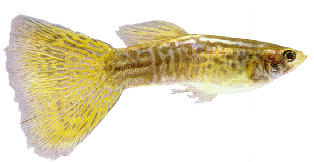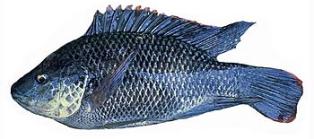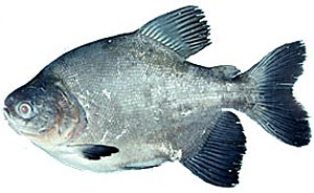

|
|
|
|
|
This is a group of miscellaneous freshwater fish found in Florida. The
group contains the American Eel, American Shad, Atlantic Sturgeon,
Bowfin, Golden Shiner, Mosquito Fish, Shortnose Sturgeon, Skipjack
Herring, Kuhli, Mozambique Tilapia, and Pacu. These freshwater fish do
not fit into any of our other categories so we have grouped them
together in these two pages. Mosquito
Fish (Gambusia holbrooki) The mosquito fish is a
diminutive silver-colored, live-bearing minnow that is common throughout
Florida. A greenish tinge is sometimes noted especially when looking
down on the back of the fish. It has a small up-turned mouth and the
area over and behind the head is somewhat flattened. Normally found in
the shallows among vegetation, the mosquito fish is often oriented
upward searching for larvae and creating small ripples at the surface.
The mosquito fish primarily feeds on mosquito larvae at the surface of a
lake or pond. Maximum size for the mosquito fish is about three inches
for females and smaller for males. Mosquito
Fish (Gambusia holbrooki) The mosquito fish is a
diminutive silver-colored, live-bearing minnow that is common throughout
Florida. A greenish tinge is sometimes noted especially when looking
down on the back of the fish. It has a small up-turned mouth and the
area over and behind the head is somewhat flattened. Normally found in
the shallows among vegetation, the mosquito fish is often oriented
upward searching for larvae and creating small ripples at the surface.
The mosquito fish primarily feeds on mosquito larvae at the surface of a
lake or pond. Maximum size for the mosquito fish is about three inches
for females and smaller for males. Shortnose
Sturgeon
(Acipenser brevirostrum) Sturgeon are primitive fishes,
with a heterocercal tail (the upper lobe is much longer than the lower
lobe) like many sharks. The body is covered with 5 rows of large bony
plates. These fish have a tube-like mouth located on the underside of
the head. The mouth protrudes several inches when the fish is feeding.
Shortnose sturgeon range in color from grayish-olive to brownish above,
shading to white on the belly. Shortnose sturgeon have wider mouths and
the snout is more U-shaped in the shortnose than in the Atlantic.
Shortnose sturgeon are restricted to the east coast of North America,
from the St. John River in Canada, to the Indian River in Florida.
Bottom feeders, the shortnose sturgeon uses their barbels to sense
worms and mollusks, and it's protrudable mouth to suck them up. The
largest recorded shortnose sturgeon, a female weighing over 90 pounds,
was captured in the St. John River in Canada Shortnose
Sturgeon
(Acipenser brevirostrum) Sturgeon are primitive fishes,
with a heterocercal tail (the upper lobe is much longer than the lower
lobe) like many sharks. The body is covered with 5 rows of large bony
plates. These fish have a tube-like mouth located on the underside of
the head. The mouth protrudes several inches when the fish is feeding.
Shortnose sturgeon range in color from grayish-olive to brownish above,
shading to white on the belly. Shortnose sturgeon have wider mouths and
the snout is more U-shaped in the shortnose than in the Atlantic.
Shortnose sturgeon are restricted to the east coast of North America,
from the St. John River in Canada, to the Indian River in Florida.
Bottom feeders, the shortnose sturgeon uses their barbels to sense
worms and mollusks, and it's protrudable mouth to suck them up. The
largest recorded shortnose sturgeon, a female weighing over 90 pounds,
was captured in the St. John River in Canada Skipjack
Herring (Alosa chrysochloris) A typical herring or
shad, the skipjack herring is silvery colored with a small dorsal fin,
deeply forked caudal fin and small mouth. The lower jaw on a skipjack
extends in front of the upper jaw and the fish is very compressed
(flattened side to side). There is no dark marking on the shoulder.
Primarily known from the Mississippi River drainages and other rivers
entering the northern Gulf of Mexico, the skipjack herring can be found
in freshwater areas over sand or gravel. Their name derives from the
fact that schools of these fish will jump out of the water skipping
across the surface, especially at dawn and dusk, in pursuit of small
minnows and insect larvae. Skipjack herrings can grow to about 20 inches
and weigh up to 3.75 pounds. Skipjack herring are a migratory species
that spawns in groups broadcasting their eggs and milt. Skipjack
Herring (Alosa chrysochloris) A typical herring or
shad, the skipjack herring is silvery colored with a small dorsal fin,
deeply forked caudal fin and small mouth. The lower jaw on a skipjack
extends in front of the upper jaw and the fish is very compressed
(flattened side to side). There is no dark marking on the shoulder.
Primarily known from the Mississippi River drainages and other rivers
entering the northern Gulf of Mexico, the skipjack herring can be found
in freshwater areas over sand or gravel. Their name derives from the
fact that schools of these fish will jump out of the water skipping
across the surface, especially at dawn and dusk, in pursuit of small
minnows and insect larvae. Skipjack herrings can grow to about 20 inches
and weigh up to 3.75 pounds. Skipjack herring are a migratory species
that spawns in groups broadcasting their eggs and milt. Kuhli
(Pangio kuhlii) The kuhli loach is an eel-shaped fish, elongated
with slightly compressed sides, and very small fins. The dorsal fin
starts behind the middle of the body, and the anal fin well behind this.
The eyes are covered with a transparent skin. The body has 10 to 15 dark
brown to black vertical bars, and the gaps between them are salmon pink
to yellow with a light underside. When the fish is not actively
breeding, there is no known way to distinguish between males and
females. When breeding, the females often become monstrously fat and
their greenish ovaries can be seen through the skin before spawning.
Spawning is not easy, but when it occurs a few hundred greenish eggs are
laid among the roots of floating plants. The maximum size of the kuhli
loam is 4 inches long. The natural habitat of the kuhli loach is the
sandy beds of slow-moving rivers and clean mountain streams. They are a
social fish and are typically found in small clusters. Kuhli Loaches are
scavengers, so they will eat anything that hits the bottom. Kuhli
loaches usually feed in the night time Kuhli
(Pangio kuhlii) The kuhli loach is an eel-shaped fish, elongated
with slightly compressed sides, and very small fins. The dorsal fin
starts behind the middle of the body, and the anal fin well behind this.
The eyes are covered with a transparent skin. The body has 10 to 15 dark
brown to black vertical bars, and the gaps between them are salmon pink
to yellow with a light underside. When the fish is not actively
breeding, there is no known way to distinguish between males and
females. When breeding, the females often become monstrously fat and
their greenish ovaries can be seen through the skin before spawning.
Spawning is not easy, but when it occurs a few hundred greenish eggs are
laid among the roots of floating plants. The maximum size of the kuhli
loam is 4 inches long. The natural habitat of the kuhli loach is the
sandy beds of slow-moving rivers and clean mountain streams. They are a
social fish and are typically found in small clusters. Kuhli Loaches are
scavengers, so they will eat anything that hits the bottom. Kuhli
loaches usually feed in the night time Mozambique
Tilapia (Amia calva) Mozambique tilapia are typically
gray to black with an enlarged jaw and slightly concave snout. Tilapia
are shaped much like sunfish or crappie but can be easily identified by
an interrupted lateral line characteristic of the Cichlid family of
fishes. They are laterally compressed and deep-bodied with long dorsal
fins. The forward portion of the dorsal fin is heavily spined. Spines
are also found in the pelvis and anal fins. There are usually wide
vertical bars down the sides of fry, fingerlings, and sometimes adults.
Mozambique tilapia are commonly found in warm weedy ponds, canals, and
river backwaters. The Mozambique are omnivores that consume plankton,
and aquatic invertebrates, and decomposing organic matter. They are
considered filter feeders because they can literally filter plankton out
of the water. The Mozambique are native to Africa and the Levant, but
have been widely introduced into tropical fresh and brackish waters
around the world. In some cases, the introductions were deliberate, for
example to control invasive aquatic plants, as in Florida and Texas. Mozambique
Tilapia (Amia calva) Mozambique tilapia are typically
gray to black with an enlarged jaw and slightly concave snout. Tilapia
are shaped much like sunfish or crappie but can be easily identified by
an interrupted lateral line characteristic of the Cichlid family of
fishes. They are laterally compressed and deep-bodied with long dorsal
fins. The forward portion of the dorsal fin is heavily spined. Spines
are also found in the pelvis and anal fins. There are usually wide
vertical bars down the sides of fry, fingerlings, and sometimes adults.
Mozambique tilapia are commonly found in warm weedy ponds, canals, and
river backwaters. The Mozambique are omnivores that consume plankton,
and aquatic invertebrates, and decomposing organic matter. They are
considered filter feeders because they can literally filter plankton out
of the water. The Mozambique are native to Africa and the Levant, but
have been widely introduced into tropical fresh and brackish waters
around the world. In some cases, the introductions were deliberate, for
example to control invasive aquatic plants, as in Florida and Texas. Pacu
(Colosomma spp.) Pacu look similar to piranha but have
molar-like teeth and grow to much larger sizes. Due to their popularity
in the aquarium industry, individual pacu have been collected a number
of times from Florida waters. All Pacus grow very fast to very large
sizes. They can eat almost any food, and are now being raised in huge
fish farms throughout the world as a food fish. Pacus are relatives of
the Piranha, and Pacus look like Piranhas. But Pacus are mainly
vegetarians that will adapt to eat almost anything. In the wild they eat
very hard nut-like vegetation that they crush in their powerful mouths. Pacu
(Colosomma spp.) Pacu look similar to piranha but have
molar-like teeth and grow to much larger sizes. Due to their popularity
in the aquarium industry, individual pacu have been collected a number
of times from Florida waters. All Pacus grow very fast to very large
sizes. They can eat almost any food, and are now being raised in huge
fish farms throughout the world as a food fish. Pacus are relatives of
the Piranha, and Pacus look like Piranhas. But Pacus are mainly
vegetarians that will adapt to eat almost anything. In the wild they eat
very hard nut-like vegetation that they crush in their powerful mouths.
|
|
|
Advertise | Privacy Statement | Dog Encyclopedia | Video |Contact | Alaska Nature |
|